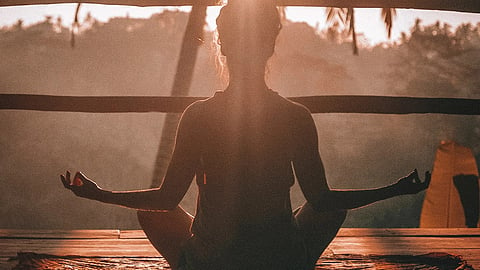

Setting one's needs first and making time for relaxation, meditation, or exercise are just a few of the straightforward self-care practices that can significantly improve a woman professional's quality of life. They communicate to the rest of the family that this is their "me" time and that they should not be disturbed by others by establishing personal boundaries. Only by beginning with such modest acts of self-care as yoga can women reclaim some of their own time for vital self-care.
Some women have hormonal imbalances, which increase their risk for physical, psychological, and emotional issues. By forming a habit that enhances body strength, hormone balance, and self-acceptance, yoga helps women manage their life. 30-45 minutes of yoga, when combined with a breathing exercise like pranayama, can lower stress, increase the quality of sleep, and regulate vital bodily processes like heart rate, respiration, and blood pressure, among others. Simply carve out sometime in the morning or evening from their hectic schedules.
Navasana (Boat pose)
How to do:
Begin by lying down on the floor on your back. Keep your hands at your side and your legs together. Now, slowly lift your legs without bending them. Also, lift your upper body off the floor and stretch your arms towards your legs. Hold this position for about three minutes and then return to the original position.
Contraindications:
Do not practice this yoga pose if you have low blood pressure, severe headache, or migraine, or if have suffered from some chronic diseases or spinal disorders in the recent past. Asthma and heart patients are also advised to avoid this pose.
Vasisthasana (Side Plank)
How to do:
Start in a plank position, shift body weight into the right hand, wrist under shoulder, drop heels to the right side onto the mat, rotate the body to face left side, and lift left arm into the air at shoulder height and twist. Raise hips as high to the ceiling as possible.
Contraindications:
People with an injury to the wrists, elbows, shoulders, neck, hips, back, knees, or ankles should avoid the practice of the Side Plank Pose. Any injury to the muscles of the legs, back, and arms are contraindications, and people should avoid the same.
Urdhva Mukha Svanasana (Upward-Facing Dog)
How to do:
Start by lying on a mat with legs extended straight behind the body, front of legs resting on the floor, and upper body propped up in the air by pressing palms down into the mat. Extend arms to straight and lift thighs and shins off of the floor.
Contraindications:
It is always safe to take practice this pose with ease if one is suffering from a slipped disc or better still with the guidance of an experienced teacher. The deep stretch at the upper back including the neck and head, may not suit people having spondylitis. It is safer to go slow or take guidance from an expert.
Bhramari Pranayama
How to do:
Do preliminary conditioning in Sukhasana or any other meditative posture. Sit on a firm chair with an erect backrest, if unable to sit on the floor. Keep the body above the waist straight and the spine erect. Inhale fully and then exhale slowly, smoothly, and continuously in a controlled manner from the nostrils with a little force, making a humming sound like the black bee. Keep your mouth closed throughout the practice. The sound need not be very loud but should create vibrations. Practice 5 rounds/session, with pause in-between rounds.
Contraindications:
Bhramari should not be practiced by pregnant or menstruating women. It is also contraindicated for individuals with extremely high blood pressure, epilepsy, chest pain, or an active ear infection.
Anulom-Vilom Pranayama
How to do:
Close your eyes and sit in Padmasana. Use the right thumb to close the right nostril. Inhale slowly through the left nostril, taking in as much air as you can to fill your lungs. Remove the thumb from your right nostril and exhale. While exhaling, use the middle finger to close your left nostril and inhale with your right nostril. Remove the thumb from the right nostril and exhale. Perform for 2-5 minutes.
Contraindications:
It should not be practiced by those people who are under medication for blood pressure. The same can be done without holding the breath within, and immediately exhaling.
Ujjayi Pranayama
How to do:
Begin by inhaling and exhaling naturally. Bend down your head, blocking the free flow of air, and inhale as long as you can, making a sound from your throat. Hold for 2-5 seconds. Close your right nostril with your right thumb while exhaling, and breathe out through the left nostril. Repeat 10-12 times in as much time as you need.
Contraindications:
Do not practice this pranayama if you are constantly feeling tired, anxious, and panicking because exertion can be harmful to the lungs and the heart. Always practice under a Professional Yoga Teacher. Beginners should not practice this breathing for more than five minutes a day.
Kapalbhati Pranayama
How to do:
This breathing technique involves passive inhalation and active exhalation. So inhale normally, breathe in as much air as possible, and exhale forcefully. Try to pull your stomach muscles as closely as you can towards the backbone during exhalation. Perform for 2-5 minutes.
Contraindications:
Individuals with high or low blood pressure, heart disease, hernia, gastric ulcer, epilepsy, vertigo, migraine headaches, significant nosebleeds, detached retina, glaucoma, and a history of stroke should avoid this yoga pose. For anyone who has undergone recent abdominal surgery, it is recommended to practice this pose under the guidance of an expert. (HN/NewsGram)
